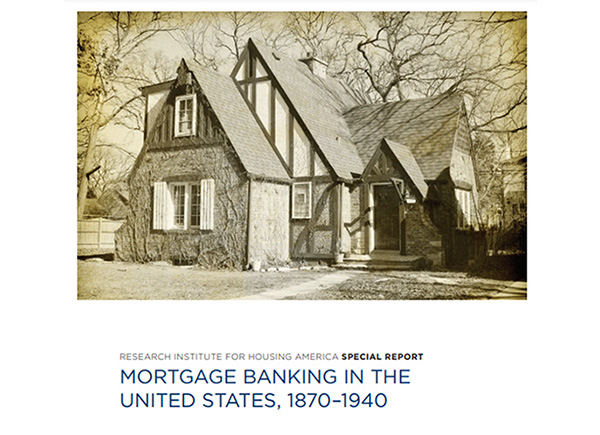
MBA’s RIHA Commemorates 10-Year Anniversary of RIHA’s Special Report on the History of Mortgage Banking

The Mortgage Bankers Association’s (MBA) Research Institute for Housing America (RIHA) is re-releasing Mortgage Banking in the United States, 1870-1940, to commemorate the 10-year anniversary of the renowned white paper.
“This report provides a historical analysis of mortgage banking in the United States and contains a critical view of how the real estate finance industry has evolved,” said Kenneth A. Snowden, PhD., author of the report and Emeritus Professor of Economics at University of North Carolina, Greensboro. “Examining and understanding the past is a powerful way to gain insight and develop solutions to tackle the opportunities and challenges in today’s mortgage and housing markets.”
As noted in the report, from 1870 to 1940, the mortgage banking industry in the United States was a dynamic and entrepreneurial sector that took on different shapes and developed a variety of different mechanisms to originate, service, and fund mortgage loans.
“The popularity of this RIHA paper has gained traction in recent years as many industry professionals are trying to understand the successes and challenges faced in previous time periods in American history,” said Edward Seiler, Executive Director, Research Institute for Housing America, and MBA’s Associate Vice President, Housing Economics. “It is a fascinating, retrospective, and systematic narrative that highlights many lessons for our industry as we still grapple with the effects of the Great Financial Crisis, and more recently, the impacts of the COVID-19 pandemic.”
Key findings of Mortgage Banking in the United States, 1870-1940 include:
During this period, the mortgage banking industry experienced periods of remarkable stability and severe crisis. However, the mortgage banking ecosystem, even back then, was dynamic and entrepreneurial and was able to take on different shapes and developed a variety of different mechanisms.
During their early pre-federal intervention periods, farm and urban mortgage bankers focused on three similar elements:
• The use of informal guarantees or explicit mortgage insurance to protect and attract investors in the markets for whole mortgage loans
• The development of correspondent relationships with life insurance companies
• Failed experimentation with European-style covered bond programs
The Federal Farm Loan Bank (FHLB) system and the FHA mortgage insurance programs that restructured both the farm and urban mortgage banking sectors shared three common features:
• Encouraged the widespread adoption of long-term, amortized mortgage loans
• Created mechanisms to stimulate the inter-regional transfer of mortgage credit and the convergence of mortgage rates and lending terms across regions.
• Established federal chartering systems for privately financed, European-style mortgage banks to create active secondary markets for long-term, amortized loans
MBA’s RIHA is a 501(c)(3) trust fund. RIHA’s chief purpose is to encourage and assist – through grants to distinguished scholars and subject matter experts, educational institutions, research facilities, and government organizations – establishment of a broader-based knowledge of mortgage banking and real estate finance. You can find additional studies on RIHA’s website: www.housingamerica.org
